Note: This website was automatically translated, so some terms or nuances may not be completely accurate.
The Case for Communication Research: Why TV Stations Operate News Sites

Kotaro Osaki
Dentsu Inc.

Toshihiro Shimizu
Fuji Television Network, Inc.

Terakio
Fuji Television Network, Inc.
Fuji TV released the "Houdoukyoku" news media app on May 24.
It delivers a variety of content daily, including live news video streams, short summary clips, VR videos offering 360-degree views of scenes, text updates, and article analyses by reporters and experts. What exactly is the broadcaster aiming for beyond operating a news site and releasing an app?
Kotaro Osaki of Dentsu Inc., who handled the app's promotion strategy, discussed "The Future of Television News" with Fuji TV's Toshihiro Shimizu and Kazuo Teraki, who oversee Houdoukyoku.
The act of re-creating content as a broadcaster
Ōsaki: First, could you share the background behind Fuji TV, as a corporate entity, launching a web-based news service as a new business venture?
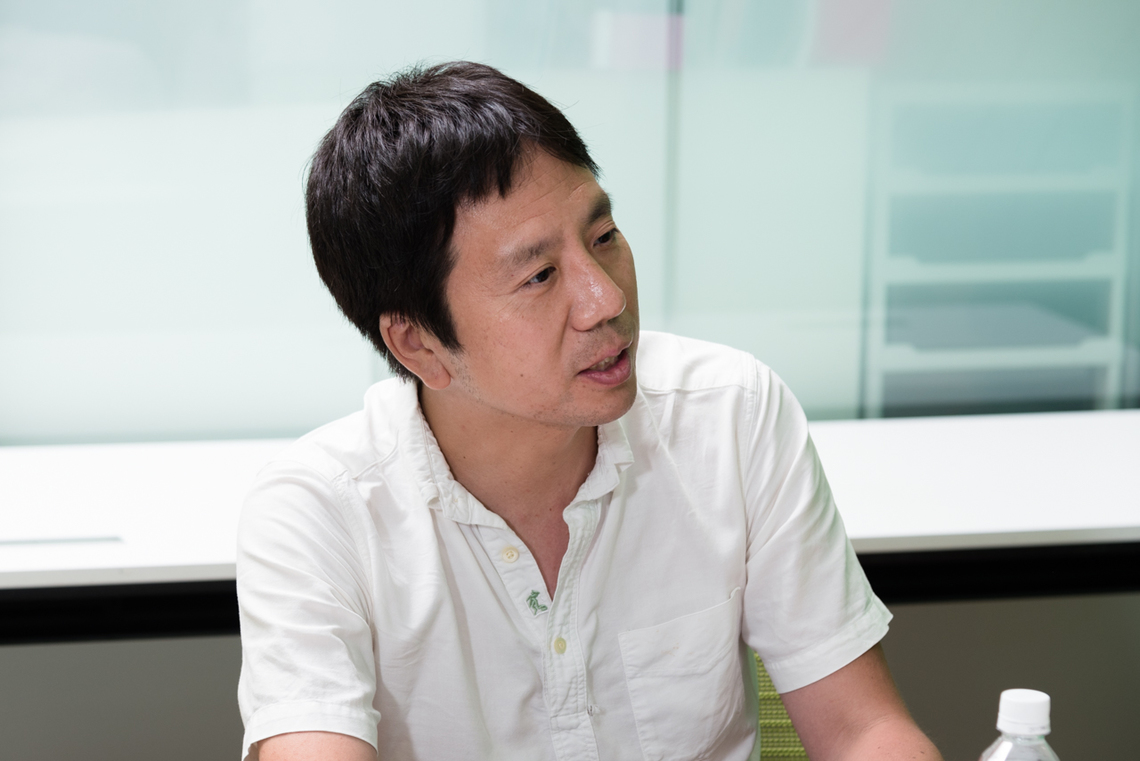
Shimizu: I was also involved as a founding member. Houdoukyoku launched in April 2015 as a 24-hour live streaming service, distributed via FOD (Fuji TV On Demand) and the smartphone broadcasting station "NOTTV."
Since we had to keep streaming content 24/7, there were times when no other talent was available and I ended up going into the studio myself. I've handled various programs, but broadcasting something like "24-Hour TV" every day with such a small team was a first for me (laughs).
However, midway through, NOTTV itself decided to end its service. That forced us to rethink whether Houdoukyoku should continue broadcasting 24 hours a day as before.
So, after conducting research, including observing American online services, we relaunched on October 24th last year. We transformed it into a news site that delivers what you want to see, when you want to see it. This went beyond just live streaming, incorporating on-demand videos, text, infographics, VR, and more.
While maintaining the infrastructure of our 24-hour live streaming service, we decided that even though we stream around the clock, we don't need to force ourselves to create content for the entire 24 hours when there's no new information. So, we've adopted our current format, which incorporates repeat broadcasts and other elements.
As a result, I believe we've achieved a unique news service that's quite difficult to replicate.

Osaki: For broadcasters, while there are news programs aired over the "broadcast waves," isn't there internal discussion about whether simultaneously developing news coverage on the "internet" as well might lead to cannibalization of the business when viewed from the company's overall perspective?
Tera: Cannibalization hasn't been a particular concern; rather, we feel collaboration is progressing well. For example, we take content aired on "Your Time" and repurpose it into articles the next day, making it available to read on smartphones. This is what we call "content regeneration," and I believe it will become a crucial perspective for future collaboration between television and the internet.
We operate under the philosophy that the value lies in taking content originally presented in a format suitable for TV broadcast, then re-creating it in a format suitable for smartphones and distributing it again. We actually feel this represents progress.
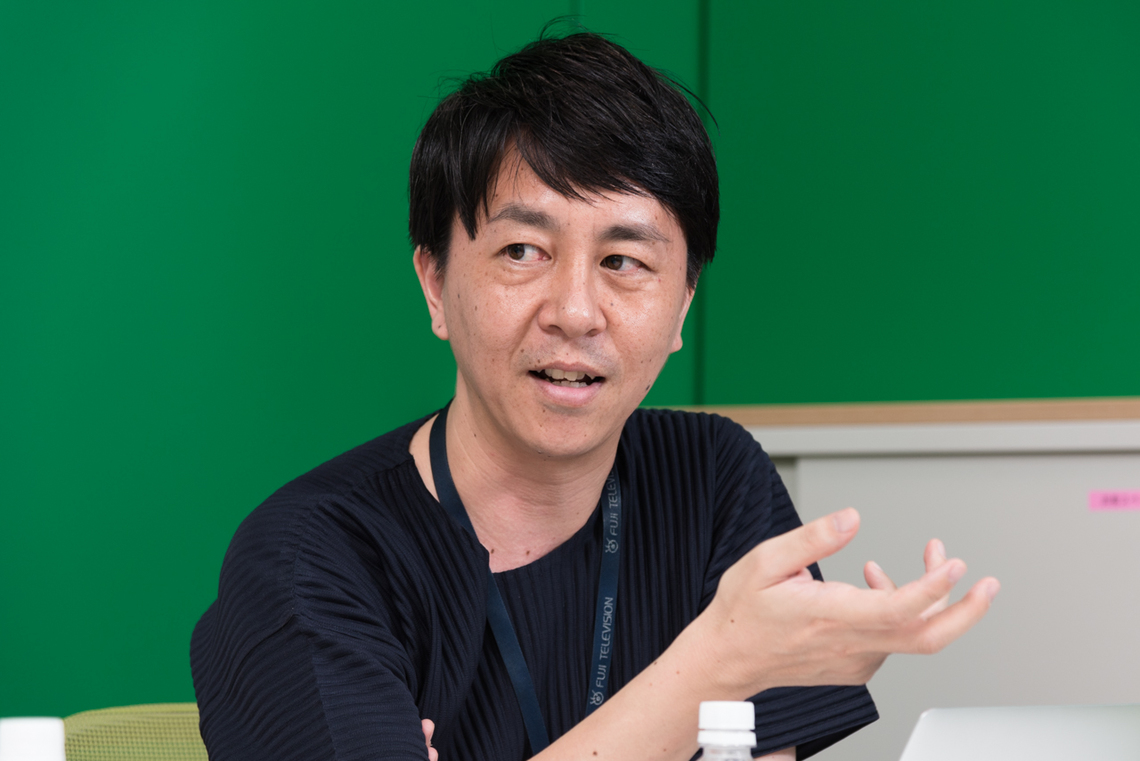
Shimizu: This might sound like I'm tooting our own horn, but while our company has produced hit movies like "Bayside Shakedown," no employee has ever said, "Movies cannibalize TV dramas, so we should stop making them!"
Both those who watch our movies and those who watch our dramas are our customers. Some people see the movie first, find it interesting, and then watch the drama. Others, who already liked the drama, go to the theater to see the movie. Each has created synergy.
It's exactly the same structure. Those who watch Fuji TV's television news and those who watch news on Houdoukyoku are both our customers. Far from cannibalizing each other, they only work to each other's advantage.
Osaki: Is there any prior coordination within the company, like segmenting news distribution or separating programming between TV broadcasts and Houdoukyoku?
Shimizu: We constantly exchange opinions and hold regular meetings with the core news team. But we don't have pointless debates like, "We're running this news story on terrestrial TV at this time, so don't run it on Houdoukyoku at the same time." Instead, we actively aim for both platforms to coexist.
For example, if we get a full hour interview with Philippine President Duterte, but terrestrial TV requires cutting it down to 10 minutes, we might request streaming the entire hour online because discarding the rest would be wasteful. We try to leverage each platform's strengths.
Tera: Online, primary information is distributed by other TV stations, newspapers, and news agencies like Jiji Press. For us, we want to build our online presence, especially on social media. Simply releasing primary information isn't enough. We believe it's crucial to provide information with added commentary – essentially "1.5-tier information" – at the right time.
At Houdoukyoku, we prioritize the approach of having our commentators and reporters immediately provide explanations like "What is the background?" or "What does ~ mean?" for breaking news, processing it into a form users can understand before distribution.
Shimizu: Regarding "processing it into a digestible form," for example, we adapted the exchange between Prime Minister Abe and Representative Renho during their party leader debate into a LINE-style format for younger audiences. While we also offer videos and full-text articles for those seeking deeper understanding, we thought younger users might find the LINE chat-style format easier to read and comprehend.
Osaki: Speed is crucial when converting primary broadcast information into secondary information tailored to web users' behaviors and preferences. This is achievable precisely because of the broadcaster's strengths: human resources, information research capabilities, and news management expertise. Are the staff involved in Houdoukyoku primarily television broadcast journalists?
Shimizu: While we don't have a large dedicated staff for Houdoukyoku, the primary information comes from all the TV broadcast news staff. We have a system where about 100 reporters and commentators provide scripts and information, enabling us to deliver new news faster.
The mindset within the company has also changed. Previously, some people genuinely believed that simply reposting what aired on TV online was sufficient. They wanted to repost the TV broadcast content word for word.
But even if you transcribed the entire script read by the anchor, it's text tailored to the pacing of a TV broadcast—it's text designed to accompany visuals. Reading it as plain text is completely uninteresting.
For example, when turning "Your Time" broadcasts into text articles, we change the title. We also adapt the parts read by the anchor into a text-friendly format, altering the flow and order of the discussion. The key point is to deliver news in a form that's easy for users to receive.
Are curated media platforms competitors?
Osaki: Curation media has become a hot topic in various ways recently, and similar services are proliferating. Are news curation media platforms competitors for Houdoukyoku?
Shimizu: In a broad sense, they are competitors. However, there is definitely a demand for the diverse genres of content gathered on platforms like SmartNews and Gunosy, so it's only natural that people gather there.
It's not about "eliminating them!" Instead, we prioritize getting our content in front of as many people as possible while also being present in those spaces. However, we're confident that if people want to truly enjoy our content, it's absolutely easier to view and more engaging on our own site or app.
Having primary sources and processing them ourselves gives us a clear advantage and allows for deeper expression. While they are competitors, we also see them as partners who introduce our content.
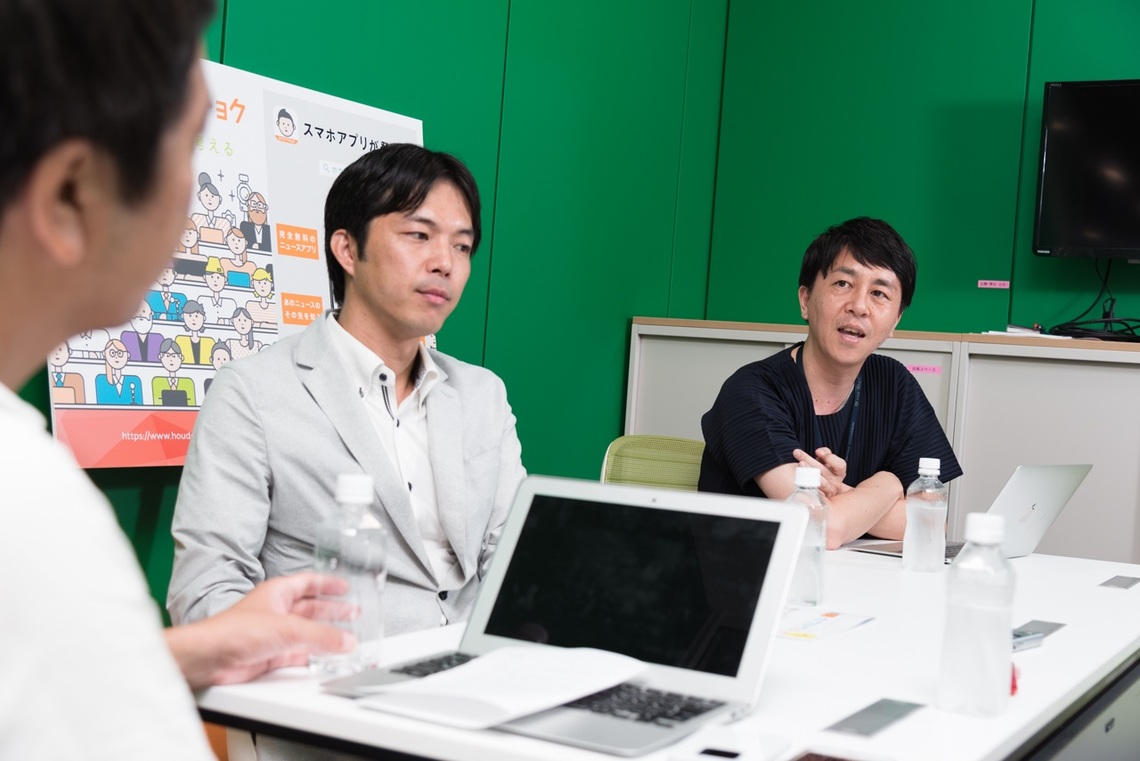
Tera: There's a lot to learn from curation media. I think media is a kind of brand, and we've been constantly thinking about how to build Houdoukyoku into a fully-fledged brand.
In that context, I believe successful curation media aren't just borrowing content from other sources. They earn support because everything—from their editorial and planning capabilities that establish the media brand, right down to how they title their pieces—has a clear, consistent foundation.
Therefore, I don't see them as enemies. What the TV industry needs is a humble attitude to learn from these excellent aspects. After all, the pattern for TV stations has always been to underestimate internet services and then get tripped up (wry smile).
Osaki: What kind of content is frequently viewed on Houdoukyoku? If there are features unique to web services that differ from television news, please share them.
Shimizu: First, topics we call "within a 5-meter radius" – things close to people's lives. Like a roundtable of young employees' honest feelings saying, "Please don't suddenly invite us out for drinks," or "The borderline between sexual harassment and non-sexual harassment."
Then, content like North Korea news, which is also popular on terrestrial TV, is frequently viewed on Houdoukyoku too. I think that's because we have a lot of exclusive content you can't see elsewhere, like inside information on North Korea or 360-degree footage from inside the Mangyongbong ship.
Also, topics like the current state of AI and other cutting-edge technology are themes that terrestrial broadcasts can't really cover in depth, yet they're popular news items. Just recently, we did a special feature called "The Day Smartphones Disappear," and it got a ton of views.
Tera: Additionally, features addressing the vague anxieties often felt by people in their 30s and 40s tend to draw strong viewership. For example, a piece like "What Happens When Your Parents Pass Away?" also performed very well.
Osaki: The service name "Houdoukyoku" doesn't include the network name like FOD (Fuji TV On Demand), so I think it's unclear whether it's a Fuji TV service. Was there a specific reason for naming the service without including the Fuji TV prefix?
Shimizu: I believe that if the content is compelling, whether it's from Fuji TV or not matters little to users. Conversely, we don't want to be constrained by the phrase "Fuji TV News" and limit the breadth of our content ourselves.
Originally, when discussing the naming with the News Division Director, we talked about wanting a service name that would immediately convey it's about news, like "Tokudane!" or "Shinsou Hodo Bankisha!"
Once program names like "Tokudane!" or "Bankisha!" became widely recognized, I think they transcended their original meanings in a way. Just saying "Tokudane!" makes you think of the TV show, right? We want to create a service that can similarly redefine the very meaning of a word.
Then, the moment I muttered, "How about 'Houdoukyoku'?" the news bureau chief's eyes lit up, and he said, "That's it!" By using katakana, we want to break down the fixed notions and rigid image that the term "news bureau" inherently carries, like "this is how news should be."
We're actively working to redefine "news" itself. For instance, we now have specialized writers who aren't part of the news division crafting our content. And we're pushing our content beyond traditional TV news programs into places like the internet and digital signage—areas that haven't traditionally been closely associated with news.
Tera: When I first heard the name, I thought the idea of writing "報道" in katakana was brilliant. We benchmark against competitors like HuffPost and BuzzFeed. Their sites let you select countries like ".uk" or ".fr" via dropdown menus, right?
I imagine something like "houdoukyoku.fr" and hope Houdoukyoku reaches that level soon. It wouldn't feel strange at all if it existed, and French people would probably happily say "Houdou Houdou," wouldn't they? (laughs).
This is totally my own wild fantasy, though. I'm a tech person, so I'm not in a position to talk about journalism, but as Shimizu said earlier, true to the spirit behind the name, I do want to create a form of reporting that's different from what people think reporting should be.
What's needed in media going forward is "researching how to convey information."
Osaki: As of now (June 2017), one difference from other similar services is your attempt to incorporate cutting-edge technologies like VR into your service. What led you to start this, and what was your intention?
Shimizu: "Covering stories and conveying them" has traditionally been the primary role of media. However, it's now commonplace to see situations where President Trump himself disseminates messages via Twitter, or where ordinary people share information on Facebook faster than established media outlets.
Essentially, we've entered an era where anyone can simply gather and report news. Therefore, I believe the future role of media should extend beyond just "gathering and reporting" to also encompass "researching how to communicate effectively." Previously, it was sufficient to focus solely on reporting methods suited for television broadcasts.
But going forward, we must consider how to convey information that cannot be effectively communicated through the television device. For example, we need to research and understand better than anyone else whether VR can be used to convey certain information, and when using VR would be more effective.
We don't yet know how far VR will advance, but media companies that dismiss it as "just VR" right now will be completely unprepared when new devices or technologies emerge. It's unlikely someone who never made games for the NES could suddenly create great games for the Super NES.
Those who built expertise on the Famicom can adapt to the Wii, the Nintendo Switch, or even mobile games. Even if VR doesn't catch on widely, the research we do now on how to communicate effectively will undoubtedly pay off in the future.
Tera: In terms of researching communication methods beyond VR, we've recently been streaming live at least once a day on platforms like LINE LIVE, Facebook Live, and Periscope.
So, how do we technically make this happen? It's actually not difficult at all. I bought a live encoder for about ¥50,000 from a junk shop in Nakano Broadway, set it up in the studio, and that's what we use.
Even with mature technology like this, how you use it matters. So, I want to keep researching communication methods from various angles, not just focusing on the latest tech.
Shimizu: I went to cover the South by Southwest (SXSW) Interactive Innovation Awards, but I made a rule to go without a camera and only shoot with my smartphone.
So, we actually filmed the award-winning video by a University of Tokyo student team using just smartphones, and it aired on terrestrial TV. Media from all over the world were at the SXSW venue, but hardly any had a team as large as ours – with reporters, sound engineers, and assistants.
If we keep thinking "that's just how it is" forever, we'll lose all competitiveness on the global stage. When human resources are limited and mobility is essential for coverage, I believe Houdoukyoku can do so much more research into how to communicate effectively using this device and this team size!
The app as one distribution channel
Osaki: Please tell us the background behind launching the app at this point, roughly two years after the service began in 2015.
Shimizu: When we launched the service in 2015, our primary focus was on building scale as a media outlet, so we concentrated solely on creating content. Starting in the fall of 2016, we adopted a distributed media strategy. We began distributing Houdoukyoku news to platforms like Y!News, SmartNews, Gunosy, Facebook, and Twitter, while researching the most effective distribution methods for each platform.
As the service grew to a certain scale, we started getting questions from various quarters: "Why doesn't Houdoukyoku have an app?" During Mao Asada's retirement press conference, we received many comments like, "I didn't know Houdoukyoku was streaming it on the web. I wish they'd sent me a push notification."
While pursuing our approach as a distributed media outlet, we concluded that having our own app as one of the content distribution channels was the natural step to further improve user convenience.
Osaki: It hasn't been that long since we released the app, but compared to when we didn't have one, have you noticed any changes in user behavior or new insights?
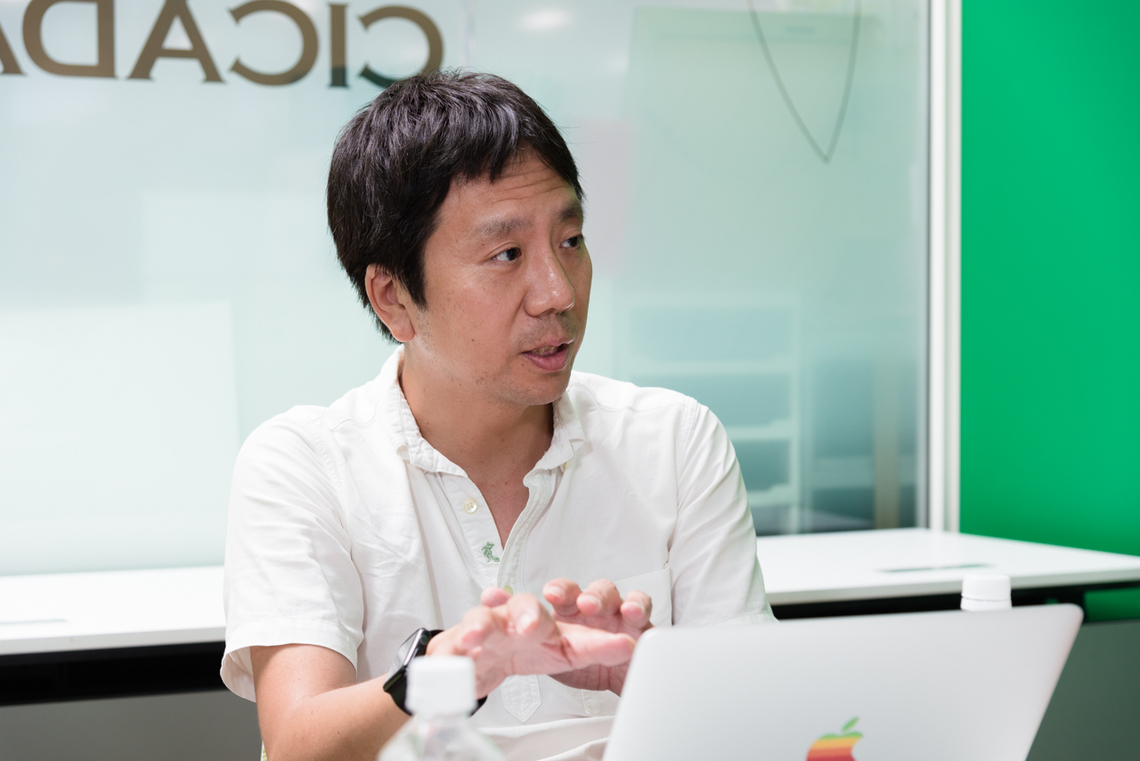
Shimizu: We haven't gathered enough data yet to speak with clear evidence, but since various genres of content continuously appear as users scroll within the app, I get the sense that many users stay for extended periods, thinking, "Wow, Houdoukyoku has this much content!"
Osaki: Tell me about monetization. Generally, for web services, acquiring users is the priority. You grow the user base to a certain scale, and only after crossing that threshold do you start thinking about monetization. How does Houdoukyoku approach this? I'd also like to hear about your business model.
Tera: Our overall plan is to establish the foundation for a viable business this fiscal year and then focus seriously on monetization next year. We're primarily considering advertising as our core revenue stream and have already started small trials with branding ads.
Looking ahead, we see various possibilities by expanding the app and website features. For example, community functions. While this is still in the future, we could potentially become a platform that matches users based on their preferences and needs, derived from data on the articles they read.
Osaki: Having worked on app development and web service operations myself, I can't help imagining all the things we could do specifically because it's an app (laughs). Are there any other features besides community functionality you're considering implementing in the app?
Shimizu: We're thinking about things so new that you might ask, "Is that even a service a news outlet should be considering?" I almost want to show you our current proposal (laughs). Because we're focused on "researching how to communicate," we're starting from the question: what kind of features wouldn't be found in existing news apps?
We're working to create something that, when looked back on later, will make people say, "Houdoukyoku was doing that back then?" Details will be a treat to look forward to in the future.
Osaki: Regarding the future of the app, is there anything else you can share at this point?
Tera: This is still in the conceptual phase, but we plan to work on AI and location information. AI can also be used on the content-creating side—essentially, AI reporters. We think some users might actually prefer the AI reporter.
Also, regarding location data, I often listen to news while moving instead of reading text. I think it would be great if the smartphone could sense location, determine if the user is moving, and then deliver information audibly if they are.
Osaki: Establishing and maintaining a system that streams content 24 hours a day must be incredibly difficult, beyond what I can imagine.
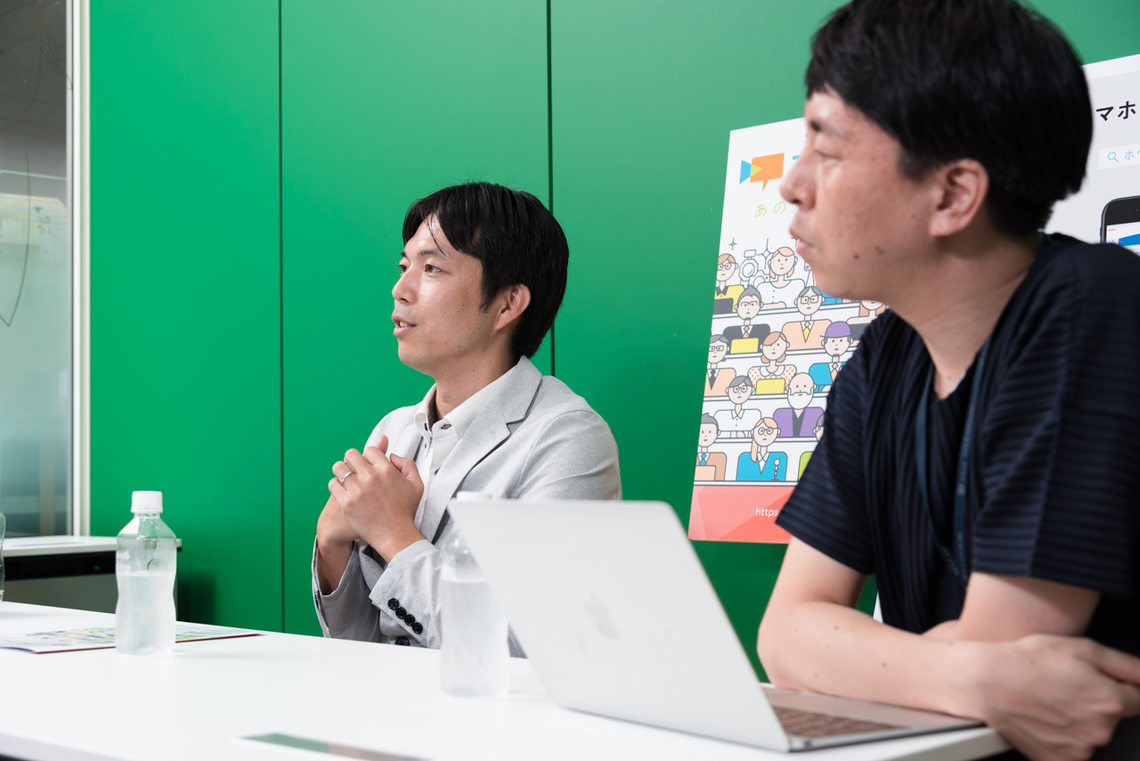
Shimizu: Having been on the reporting frontlines myself for so long, I understand that even during the year-end and New Year holidays, someone is always on duty at the news center. This is for emergency responses to incidents or earthquakes. By utilizing that existing human resource, we can steadily increase information dissemination from the news center.
It's a system that allows us to turn the vast amount of information accumulated through daily reporting activities into content and disseminate it, rather than discarding it as waste just because it didn't fit into TV program slots. Of course, there are things to learn initially, but for those who see it as expanding what we can do and where we can publish, it's incredibly exciting.
From my experience, as a reporter, having more outlets to share information is incredibly valuable. So, the addition of Houdoukyoku as a new platform doesn't mean "more work."
The Significance of a Service Combining Video and Text
Osaki: I find it distinctive and interesting that your service combines not only "video," which is a broadcaster's strength, but also text-based "articles." What was the intention behind creating such a hybrid service?
Tera: The term "article conversion" is frequently used within Houdoukyoku. The concept we're pursuing now—making television readable—is quite intriguing, don't you think?
I believe this will become commonplace in 5 to 10 years. It's crucial to make content not just watchable on TV, but also listenable while commuting and readable during short breaks. Establishing a strong online presence, especially on social media, is vital. This is something both "Mezamashi TV" and "Tokudane!" absolutely should pursue.
By doing this, we can acquire new users on smartphones, which should help elevate Fuji TV's overall audience.
Shimizu: After "Wide Na Show" airs, its content gets posted online almost every week and becomes a huge topic. I find it frustrating that we don't do this ourselves, while other companies recognize its value and use it. Since we own the content, we could transform it into even more interesting ways to present it ourselves.
What we can do with the archive
Osaki: Past footage should hold immense value in the broadcasting business. I believe leveraging this for web business could potentially hold even greater value than for broadcasting itself. How long does Houdoukyoku retain its past video archives?
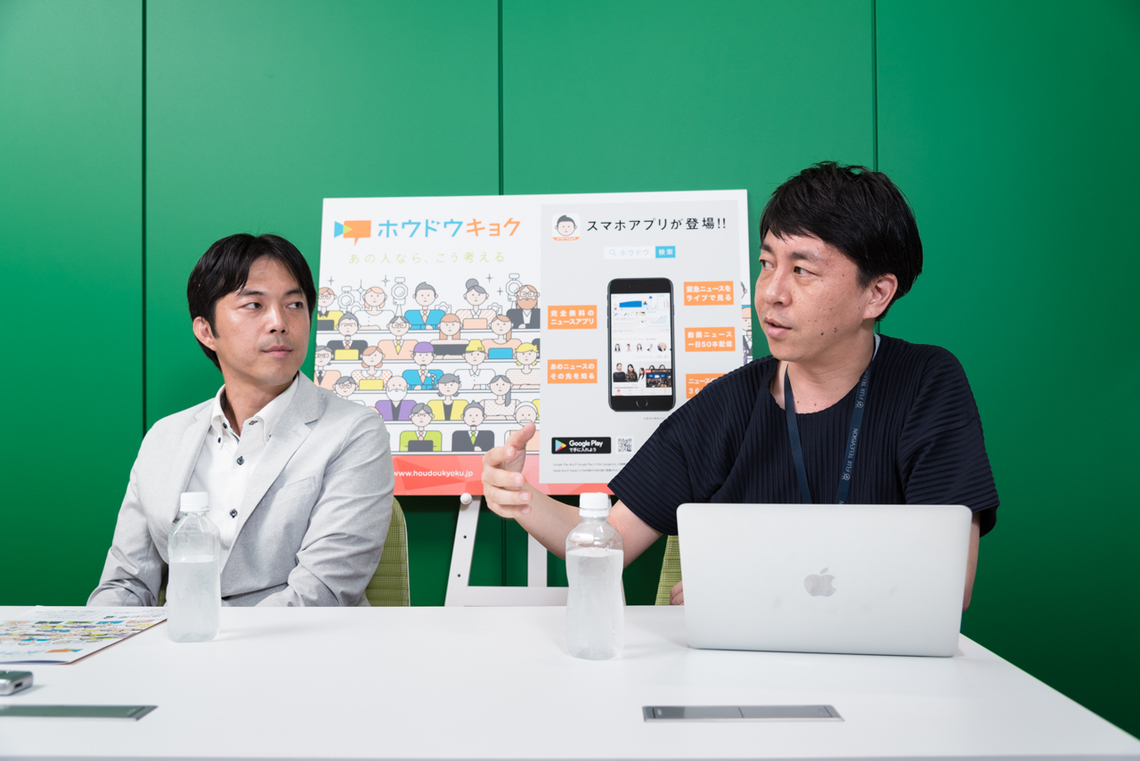
Terada: Honestly, we're open to any number of years for that, but we start with a one-year archive and extend it as needed. Relatedly, it's extremely important to preserve not just the video but also the text online.
That's because text is essential for search engine visibility. If content doesn't appear in search results, it effectively remains inaccessible to most people. By converting to text, search engines can index it, allowing unexpected audiences to discover our work. It also enables distribution via RSS feeds to platforms like SmartNews and Gunosy.
As the entire TV industry comes to truly grasp the importance of making content discoverable online in this way and the value of giving content fluidity, I believe the approach to content will naturally evolve beyond just news reporting. It will take the form that Houdoukyoku is currently working on.
Shimizu: There's another benefit to having articles as text: those articles can be reused as drafts later. Having text articles makes it incredibly easy to look back at past content. That's much harder with video (wry smile).
Tera: Similar to archives, in broadcasting, I think a lot of footage gets shot but never used and just disappears. This includes material that was never used in the first place, or parts that were cut during editing because the broadcast time didn't allow for everything to be used. Utilizing that unused footage is incredibly valuable.
Shimizu: Exactly. With a platform like Houdoukyoku, we can bridge the gap between users who think, "Actually, I wanted to know that too," and reporters who have information they want to share. I'm confident that by utilizing information and footage that has lain unused until now, we can definitely build a great service.
Tera: This came up recently when I was talking with someone from an online-only news media outlet. They mentioned that TV station video archives are extremely useful for creating chronological fact-check content and expressed a desire to utilize them.
Osaki: Finally, how do you envision the future of the Houdoukyoku service? Please share your thoughts, Mr. Shimizu and Mr. Tera.
Shimizu: In a nutshell, we want to make Houdoukyoku content accessible anytime, anywhere—not just on smartphones. Currently, Houdoukyoku content is also shown on the Shibuya Loft Vision screen, and we want to significantly increase such venues and opportunities.
We also want to constantly adapt as communication and devices evolve. Looking ahead, we want to create new ways of conveying information for the next era—things like making it viewable via AR or wearable devices, or even redefining what news and media mean.
Tera: I believe we need to diversify our business 360 degrees so we don't rely solely on broadcasting revenue. For example, in the US, tech media companies host major conferences, drawing people from around the world and monetizing those events.
I believe Houdoukyoku can achieve similar expansion in Japan. Beyond that, we should establish a business model across all fronts—publishing books, offering real-world lectures like university courses, and monetizing community features as mentioned earlier. This is the direction Houdoukyoku should pursue moving forward.
Osaki: I'm really looking forward to seeing what Houdoukyoku does next. Thank you for your time today.
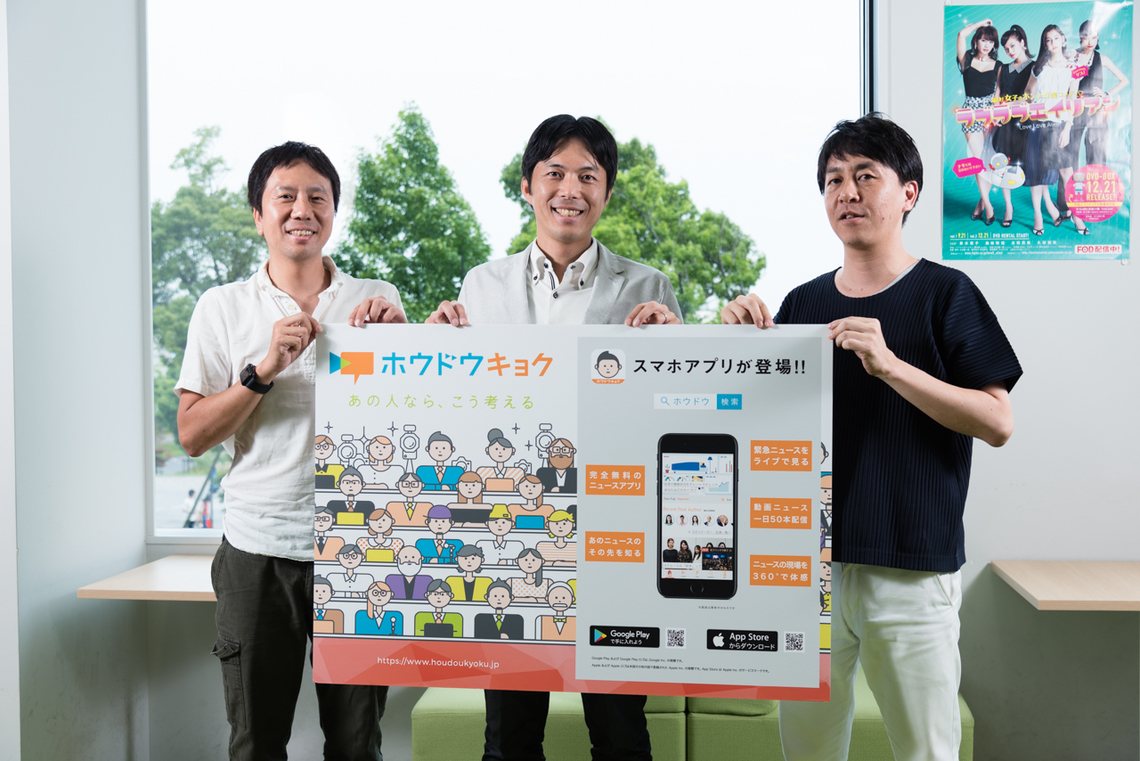
<End>
Was this article helpful?
Newsletter registration is here
We select and publish important news every day
For inquiries about this article
Author

Kotaro Osaki
Dentsu Inc.
Business Production Bureau
After working at an advertising agency and as a freelancer, joined Dentsu Inc. in 2010. Primarily handled business planning, service development and operations in the digital domain, as well as joint ventures with media companies within the New Business Division. Transferred to the Sales Bureau in June 2015. Specializes in building alliances with startups and casual conversation.

Toshihiro Shimizu
Fuji Television Network, Inc.
Leader of Fuji TV's news content strategy, including "Houdoukyoku" (https://www.houdoukyoku.jp/). Assigned to the News Division in 2002, serving in the Political Department (covering Prime Minister Koizumi, etc.), as director for "Shin Hodo 2001," overall director for election specials, and producer for "News Japan." Currently belongs to the Content Design Department, concurrently serving in the News, Public Relations, and VR Business Divisions. He is a regular contributor (Mondays) on Nippon Cultural Broadcasting's "The News Masters TOKYO." Additionally, he serves as a ProPicker for NewsPicks, a blogger for HuffPost, and a committee member for the Japan Commercial Broadcasters Association's Network and Digital Business Research Project.

Terakio
Fuji Television Network, Inc.
After working at an IT startup, joined Fuji Television. Responsible for launching various online services and program-linked initiatives. After stints at Fuji Startup Ventures and Fuji&gumi Games, joined the Houdoukyoku Project in April 2016.

